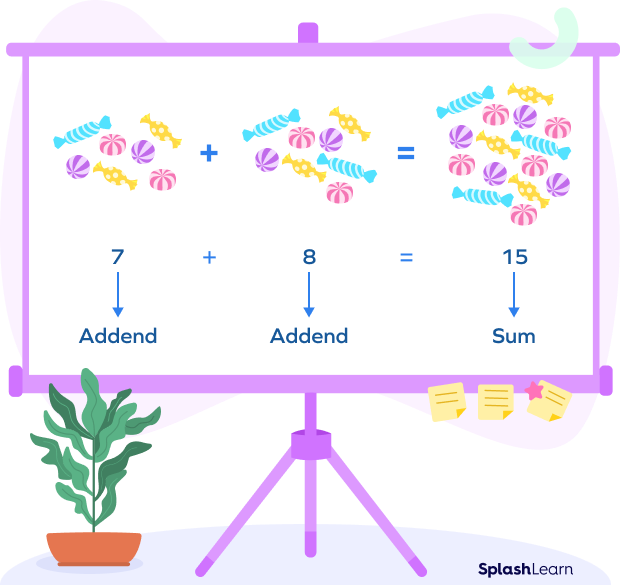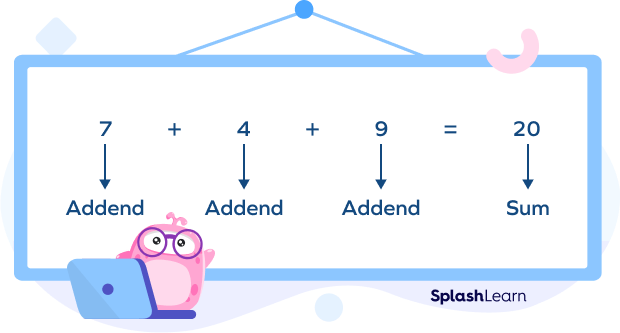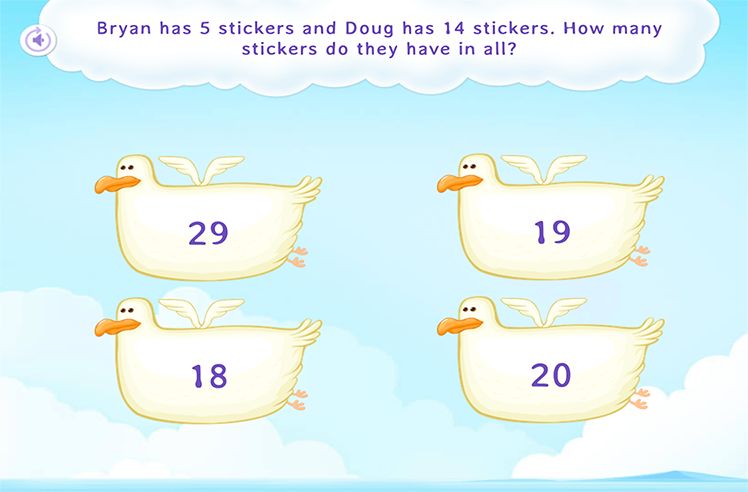Addends – Introduction
Addends in math can be defined as the numbers that we add together to get a sum. In addition, we calculate the total or the sum of two or more numbers.
Example:
Observe the image given below. How many apples are there in total?

There are 7 apples in one basket and 4 apples in the other. So, in order to find the total number of apples, we add 7 and 4. So, the total number of apples is $7 + 4 = 11$. Here, 7 and 4 are addends.
Recommended Games
What is an Addend in Math?
Addend, as we just discussed, simply refers to the numbers being added together. So, for any addition equation, the individual numbers which together form the sum are addends.
Recommended Worksheets
Addend Definition
Addends are the numbers or terms that are added together to form the sum.
Let’s consider an example. If 8 candies are added to the collection of 7 candies, we will get $7 + 8 = 15$ candies.

Here’s another example.

Different Forms of Addends
Addends are not necessarily just numbers. The following examples show their different forms.
1) $128 + 55 = 183$
In this example, 128 and 55 are the addends.
2) $3\text{x} + 5\text{y} + 6\text{z}$
Here, the addends are 3x, 5y, and 6z.
3) $2\text{yz}+6\text{x}^2\text{y}+\text{xyz}^3$
For this example, the addends are still just terms being added together: $2\text{yz}, 6\text{x}^2\text{y}$ and $\text{xyz}^3$.
Properties of Addition
Properties of addition define the different ways in which we can add the given integers. Let’s discuss a few properties of addition.
Commutative Property of Addition
According to this property, when two numbers are added, the sum remains the same even if we change their order. It can be represented as;
$\text{A} + \text{B} = \text{B} + \text{A}$
where, A and B are integers.
For example:
Let us take $\text{A} = 12$ and $\text{B} = 7$
$12 + 7 = 19$ and $7 + 12 = 19$
Thus, $12 + 7 = 7 + 12$
The order of numbers does not matter. Hence, the addition follows commutative law. The word “commute” means switching one thing for another.
Associative Property of Addition
According to this property, when we add three or more numbers, the sum will be the same, even if the grouping of addends have changed. So, the association of numbers in different combinations does not affect the sum. We can represent this property as;
$\text{A} + (\text{B} + \text{C}) = (\text{A} + \text{B}) + \text{C}$
For example:
Let us take $\text{A} = 3, \text{B} = 5$ and $\text{C} = 7$
LHS $= \text{A} + (\text{B} + \text{C}) = 3 + (5 + 7) = 15$
RHS $= (\text{A} + \text{B}) + \text{C} = (3 + 5) + 7 = 15$
LHS $=$ RHS
$15 = 15$
In this property, we use the parentheses to group the numbers. Here, the word “associate” refers to making connections with a group of things.
Distributive Property of Addition
In this property, the sum of two numbers multiplied by the third number is equal to the sum of the products when each of the two addends is multiplied by the third number separately. We can represent this property as:
$\text{A} \times (\text{B} + \text{C}) = (\text{A} \times \text{B}) + (\text{A} \times \text{C})$
Example:
Let us take $\text{A} = 2, \text{B} = 4$ and $\text{C} = 5$
LHS $= A \times (\text{B} + \text{C})$
$= 2 \times (4 + 5)$
$= 2 \times 9$
$= 18$
RHS $= (\text{A} \times \text{B}) + (\text{A} \times \text{C})$
$= (2 \times 4) + (2 \times 5)$
$= 8 + 10$
= 18
LHS $=$ RHS
The distributive property is the combination of both the addition operation and the multiplication operation.
Additive identity Property of Addition
Addition of zero and any number is always the number itself. So, the number zero is known as the “identity” of the addition operation. It can be represented as:
$\text{A} + 0 = \text{A}$ or $0 + \text{A} = \text{A}$
For example:
$10 + 0 = 10$ and $0 + 10 = 10$
We can remember this property using the word “identity.” The number zero when added to any number maintains the “identity” of that number and gives the sum as the number itself.
Rule of Change of Addends
When one of the addends changes by a certain amount, the sum changes by the same amount.
For example: Consider the following equation.
$3 + 4 = 7$
If we increase the number 3 by 2, we get
LHS $= (3 + 2) + 4 = 9$
RHS $= 7 + 2 = 9$
So, the sum also increases by 2.
Fun Fact!
- The opposite sides of a dice always add up to seven. Go ahead, roll and check!
Conclusion
In this article, we learned about addends. They are the numbers that are added together to form a sum. To read more such informative articles on other concepts, do visit our website. We, at SplashLearn, are on a mission to make learning fun and interactive for all students.
Solved Examples on Addend
1. In the sum $4 + 6 + 9 = 19$, which numbers are addends?
Solution: Since we are adding 4, 6, and 9, the addends are 4, 6, and 9.
2. Find the missing number, if $15 + \underline{}= 29$?
Solution: Missing number $= 29$ $-$ $15 = 14$
3. By which property can we say that $12 + 13 = 13 + 12$?
Solution: By commutative property of addition, we have
$a + b = b + a$ for any two numbers.
Thus, $13 + 12 = 12 + 13$ holds true by commutative property of addition.
4. Use distributive property to find the value of $2(5+9)$.
Solution: By distributive property, we have
$\text{A} \times (\text{B} + \text{C}) = (\text{A} \times \text{B}) + (\text{A} \times \text{C})$
$2 (5+9)=(25) +(29)$
$= 10 + 18$
$=28$
5. Find the missing addend if $23 + 62 + \underline{}= 134$.Solution: Missing addend $= 134$ $-$ $23$ $-$ $62 = 49$
Practice Problems on Addend
Addend in Math
Ella picked some oranges. When she picked 17 more oranges, she had 42 oranges. How many oranges did she pick at first?
Number of oranges she picked at first $= 42$ $-$ $17 = 25$
Which of the following is true for the integers A, B, and C?
Integers A, B and C hold all the properties, i.e., commutative property, associative property, and distributive property.
Jenny has 10 candies. John has 12 candies and Mary has 13 candies. Which of the following equations shows the total number of candies they have with them?
Here 10, 12, and 13 are the addends. So, the addition equation will be $10 + 12 + 13 = 35$.
Kim traveled 6 miles on Monday, 5 miles on Tuesday and 7 miles on Wednesday. How many miles did she travel in total?
Distance traveled by Kim in 3 days $= 6 + 5 + 7 = 18$ miles
If one of the addend is increased by 5, the sum
By the rule of change of addends, when one of the addends changes by a certain amount, the sum changes by the same amount. So, the sum will also increase by 5.
Frequently Asked Questions on Addend
What are addends in fractions?
Addends in fractions are two or more fractions that are added together to form a sum. For example, in the equation $\frac{1}{5}+\frac{2}{5}=\frac{3}{5}, \frac{1}{5}$ and $\frac{2}{5}$ are addends.
Can addends be negative?
Yes, addends can be negative. For example: In the sum, $($ $-$ $4)$ $+ ($ $-$ $6) = ($ $-$ 10)$, (- 4)$ and $(- 6)$ are addends.
How many addends can there be in an addition equation?
There can be an infinite number of addends in an addition equation.
What are minuend and subtrahend?
Let’s understand these terms using an example.
Consider an equation $5$ $-$ $2 = 3$.
The number being subtracted is 2. So, here 2 is the “subtrahend.”
The number from which the other number is being subtracted is the “minuend.”
So, 5 is the minuend.
What is the difference between summands and augends?
Summands is another name for addends.
For example: In the sum $3 + 4, 3$ and 4 are summands.
On the other hand, an augend is the number or term to which another number or term is added. For example: In the sum $3 + 4, 3$ is the augend.




































